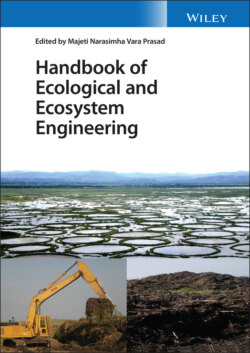Читать книгу Handbook of Ecological and Ecosystem Engineering - Группа авторов - Страница 13
1.2 Ecological Engineering: History and Definition
ОглавлениеThe basic concepts of ecological engineering were elaborated in the mid‐twentieth century, primarily through the contribution of ecologist Howard Thomas Odum. He defined it as the science that analyzes matter and energy flow in ecosystems dominated by humans to show the dependence of human production systems on natural sources, based on quantitative indices. Subsequently, Mitsch and Jorgensen [9] and Mitsch [10] have expanded the concept and defined ecological engineering as the science that accounts for the design of ecosystems and human organization to benefit both, without taking into consideration quantitative indices as determinant factors.
Figure 1.2 Searches on the Scopus database using the term ecological engineering show the evolution (1948–2019) of the number of articles, reviews, and books published in international journals that used the term.
Source: Scopus, © 2020, Elsevier.
Although the initial concepts of ecological engineering were developed in the mid‐twentieth century, studies associated with this science only started to gain room in the 1990s, as shown in Figure 1.2. The primary reasons for the increased number of studies about ecological engineering lie in the expansion of international commissions, conferences, and meetings aimed at sustainable development, such as the World Commission on Environment and Development – which published the report “Our Common Future” ‐ [11] – and the Second United Nations Conference on Environment and Development (ECO‐92).
Figure 1.3 Searches on the Scopus database using the term ecological engineering show the evolution (1948–2019), by country or territory, of the number of articles, reviews, and books published in international journals that used that expression.
Source: Scopus, © 2020, Elsevier.
Figure 1.4 Searches on the Scopus database using the term ecological engineering and shows the evolution (1948–2019), by subarea of knowledge, of the number of articles, reviews, and books published in international journals that used the term.
Source: Scopus, © 2020, Elsevier.
From the 1990s to the present day, studies about ecological engineering have increased in number, gained global range, and reached new fields of knowledge. However, China, the United States, Germany, the United Kingdom, and Australia stand out in the number of published studies in this field, whereas environmental sciences, agriculture, engineering, earth sciences, and social sciences are the subfields mostly dedicated to developing and publishing studies on this topic (Figures 1.3 and 1.4).
Although studies about ecological engineering have expanded, the view that natural ecosystems must be controlled under the basic premise of meeting human needs remains. Mitsch and Jorgensen [9] have emphasized that true ecological engineering can only be practiced based on the belief that humanity exists on the premises of Nature, which is in contrast to the current attitude that sees natural ecosystems based on conditions of human society. Human actions must move toward Nature rather than against it.
The basic ecological principles of ecological engineering were formulated as 12 guidelines or commandments [9, 12] that must be considered when planning any activity that falls under the scope of ecological engineering. These principles are described in Table 1.1.
The effective implementation of these principles is challenging, primarily in developing countries, where research resources are scarce or insufficient. In addition, production systems designed to meet global demands and balance the trade balance of these countries – such as food and input production – do not respect the slower pace required by ecological engineering, which contributes to the expansion of degradation processes in ecosystems and in services provided by them.
Table 1.1 Basic ecological principles of ecological engineering.
| Principles | Description |
|---|---|
| Forcing functions. | Ecosystem structures and functions are determined by the forcing functions of the system. According to this principle, ecological engineering interventions should stimulate the system's forces to improve the ecosystem's performance by strengthening its antifragility, i.e. by improving its structure and functions. |
| Relationships between biological function and chemical composition | Homeostasis of ecosystems requires accordance between biological function and chemical composition. |
| Recycling management. | It is necessary to match recycling pathways and rates to ecosystems in environmental management to reduce the effects of pollution. |
| Ecosystems are self‐designing systems. | The more one works with the self‐designing ability of Nature, the lower the costs of energy to maintain that system. |
| Ecosystem‐specific space–time scales. | Processes of ecosystems have characteristic time and space scales that should be accounted for in environmental management. |
| Chemical and biological diversity | Chemical and biological diversity contribute to the spectrum of buffering capacities and the self‐designing ability of ecosystems. A wide variety of chemical and biological components should be introduced or maintained for the ecosystem's self‐designing ability to choose from. Thereby, a broad spectrum of buffer capacities is available to meet the impacts of anthropogenic pollution. |
| Transition zones and agricultural management. | Transition zones are as important for ecosystems as membranes are for cells. Agricultural management should therefore consider the importance of transition zones. |
| Coupling between ecosystems and agricultural management. | Coupling between ecosystems should be used to the benefit of ecosystems in the application of ecotechnology and environmental management of agricultural systems. |
| Ecotechnology, environmental management, and components of ecosystems. | The application of ecotechnology and environmental management must consider that the components of an ecosystem are interconnected and interrelated and form a network, which implies that direct, as well as indirect, effects are relevant. |
| Ecosystem history. | It is important to realize that, overall, an ecosystem has a history in the application of ecotechnology and environmental management. |
| Ecosystems and geographical edges. | Ecosystems are most vulnerable at the geographical edges; therefore, ecological management should take advantage of ecosystems and their biota in their optimal geographical range. |
| Ecosystem hierarchy. | Ecosystems are hierarchical systems, and all the components forming the various levels of the hierarchy make up a structure that is important for ecosystem functioning. |
